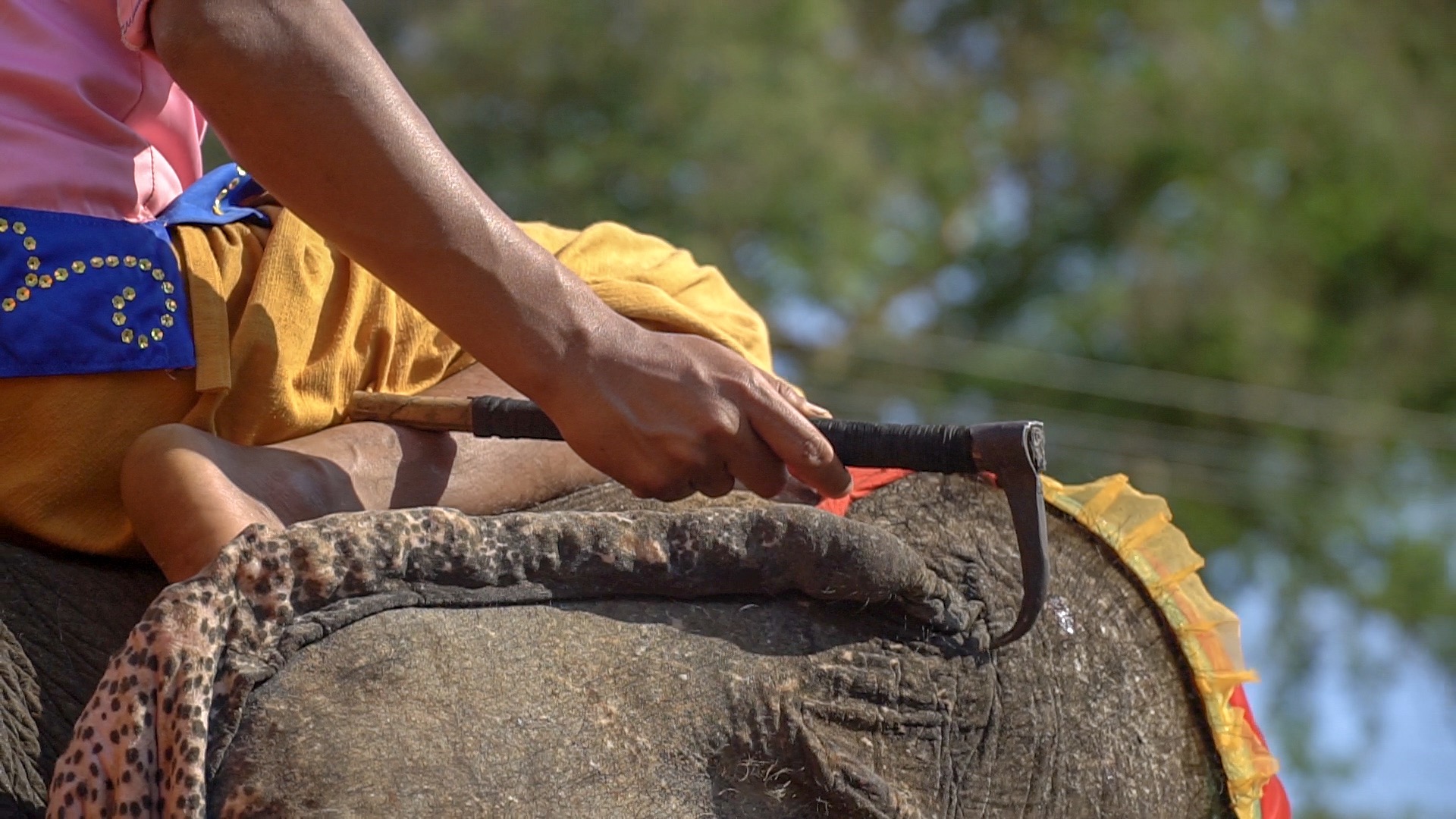The culprits behind elephant cruelty might not be who you think it is.
We stopped by Chiang Mai, Thailand as we backpacked across Southeast Asia. Trees as tall as cathedrals surrounded me, a warm light shimmered through the thick canopy of leaves, illuminating a vast clearing carved out like a makeshift amphitheater. The clearing was overflowing with people from the surrounding villages, all braving the mid-morning heat just to get a glimpse of the majestic beasts at their royal banquet.
Rubbing shoulders with the locals, I made my way to the centre and arrived at the foot of five elongated elevated platforms. On each lay a spread of the most lavish array of fruits and vegetables, bunches of bananas, cracked open watermelons and bundles of bamboo shoots all laid strewn all over for the elephants to enjoy.
National Elephant Day at Maesa Elephant Camp was a glorious celebration of all things elephant — villagers interacting with elephants, elephants performing and giving rides to visitors and even an information panel with leading elephant conservation experts and NGOs. The day’s events culminated in the iconic elephant buffet where over 70 elephants from the camp would get to feast on the fruits and vegetables to their hearts’ content.

In spite of the euphoric atmosphere, I was deeply perplexed. How could leading elephant conservation experts, who are vets and researchers, allow elephant performances and rides to occur right beneath their noses? I sought to investigate by speaking to elephant surgeons, veterinarians and researchers at Chiang Mai University, on top of secondary online research.
My research revealed a myriad of criticisms of elephant riding, citing the same few videos of a young elephant calf being pitifully chained up and brutally beaten with bullhooks. These videos served as the cornerstones of hugely influential media campaigns by organisations like People for the Ethical Treatment of Animals and World Animal Protection.
In 2016, TripAdvisor followed suit to ban all kinds of elephant shows and riding activities from their website. This wave of new age internet activism immediately cascaded on the elephant tourism industry in Thailand, leading to a rapid fall in demand for elephant rides and shows among western tourists. While the medium was unconventional, the message was clear: as far as tourists were concerned, elephant riding was bad.

Is Elephant Riding Actually Harmful?
Taking emotions aside, Elephant conservation organisations like Asian Elephant Support and Asian Captive Elephant Working Group (ACEWG) have taken a scientific approach instead. Quadrupedal animals are known to carry approximately 20% to 25% of their body weight.
For the average elephant that grows up to 2.5 to 5 tons, that’s at least 625kg to 1,250kg. Based on the Royal Elephant Kraal’s tourist information centre, the total weight of the Mahout, two tourists, a yang (chair) and blankets (padding) only adds up to 280kg, a mere fraction of the stipulated 25% of their body weight. ACEWG notes that weight will not stress the elephant as long as working hours are reasonable and the terrain is gentle.
These findings were reiterated by Linda Reifschneider, the president of the U.S. nonprofit Asian Elephant Support. “The prevalence of misinformation about elephant welfare is rampant throughout social media,” she stated, “but this misinformation brings in a lot of money to a few big players in the tourism industry”. The full interview is in the embedded video above.
Who Gains From The Ban On Elephant Riding? (Hint: Not The Elephants)

Contrary to negative connotation, “riding elephants remains very common among Thai people,” assures Dr Chachote Thitaram, a veterinarian and the Director at the Center of Elephant and Wildlife Research at Chiang Mai University. “And elephant veterinarians haven’t been able to find any scientific proof against it.”
The Rise Of Elephant Tourism
For thousands of years, elephants have played an integral role in Thai society. They have served as valiant warriors, defending the Siamese Kingdom from the Burmese army in the 15th century to faithful labourers working as the backbone of Thailand’s logging industry in the mid-1900s. However, the government ban of logging in 1986 left almost 70% of domesticated elephants and their keepers unemployed, forcing them to turn to tourism as their only way to regain a source of income.

Activist’s Effects
The wide array of elephant camps and sanctuaries in Thailand reveals the extensive reach of the work of animal activists. Almost every camp brochure and leaflet would be some form of assurance that the elephants are not abused.
This is enforced by upholding a strict ban on elephant riding and the use of traditional mahout tools such as bullhooks and chains, while adopting an interaction model that allows people to feed, bathe and walk with elephants. But if there’s nothing wrong with elephant riding, why would these camps still advertise themselves in this way?
The answer is simple: money.
The cost of maintaining a single elephant isn’t cheap. Monthly expenses of up to ฿30,000 (~US$1,000) has forced camps to adjust their practices in order to keep attracting western tourists and keep the income flowing in.

The Problem with Sanctuaries
On the surface, this might seem like a good fix. The elephants get to work in an environment that’s physically less demanding and the locals still get to support the conservation of these mammals. But that’s actually contributing to the problem.
1) The Elephants Live Sedentary Lifestyles as a Result
Despite less exercise, the elephants are constantly fed treats by visitors daily, over multiple sessions. According to Yaoprapa Mathura, a PhD candidate with the Faculty of Veterinary Medicine at Chiang Mai University, “this can lead to a higher susceptibility of diseases like diabetes among elephants.”
2) No Hooks, No Chains ≠ No Nails, No Knives
Without traditional tools, mahouts are forced to use nails and knives instead. These are easier to conceal from tourists than the traditional tools but more dangerous as they can pierce the elephant’s skin and cause fatal wounds if not used carefully.

While the hook has become a symbol of elephant cruelty, the tool is in fact integral to ensuring the well being of the animal. Dr Worapat Prachasilchai, an elephant surgeon with the Department of Companion animal and Wildlife clinic at Chiang Mai University, recounted that often when treating elephants, they require a team of up to 60 people, and the hook serves to control and calm the animal down so that they can operate on it. Without such a tool, no veterinarian or medical professional would be able to administer medical treatment to elephants.
Aside from these glaring issues, Dr Thitaram’s greatest concern is that by using elephant riding as the litmus test of elephant welfare, the industry obstructs other more telling components of elephant welfare like the availability of veterinary care, the opportunity to breed and basic nutrition.

Born to be Wild?
The Asian Elephant is a critically endangered species. Wild populations have dipped by over 50% over the last three generations. Currently, elephant conservation experts estimate only approximately 6,000 Asian elephants remain in Thailand, half of which reside in captivity.
The biggest problem is that elephants require vast amounts of land to roam but Southeast Asia’s unprecedented rates of deforestation have decimated much of the lush tropical rainforest where they once roamed free. Today, they are at higher risk of being run over by trains, electrocuted by man-made infrastructure or even hunted by poachers.
It might come as a surprise, but elephants in captivity today actually live longer and better lives than those in the wild. “Domestic elephants have access to veterinary care, good nutrition and protection from poachers,” says Mathura. She notes that the jungle habitats needed for an elephant population to survive and thrive simply no longer exists. Ultimately, domestic elephants might be the only way to build a sustainable future for the Asian elephant.

What Can We Do?
After looking at both sides of the coin, one thing is clear. Dismissing all elephant riding or boycotting elephant tourism is not the answer. This would merely undermine camps that have good practices and ultimately hinder the sustainability of elephant conservation in the long run.
What we can do is to first begin looking for camps that put elephant welfare first. A good starting point is by shortlisting camps that have attained certification from Thailand’s Ministry of Tourism and Sports. Then really look at their policies and practices through a critical lens by taking the initiative to analyse the various aspects of their operation.
Two areas that can help determine the level of care the elephants receive are the working conditions of the elephants as well as the camp’s stance on training regime.
1) Examine the Working Conditions
– Are the elephants given ample time to rest?
– Is there a fixed work-rest cycle?
– Are the matriarchal social groups present within the camp’s elephants?
– Do the elephants get sufficient exercise, nutrition and hydration?
– Does the camp employ its own veterinarian or work with government-sponsored veterinarians?
2) Stance on Training
– Does the camp have the “no hook, no chain” policy?
– Do they use positive reinforcement to train elephants, and, if so, to what extent does that work?
– How are mahouts able to control the elephants without tools? If the camp insists that it is done through verbal commands and visual cues, what contingency plans are in place for emergency situations that may occur if elephants get aggressive or feel threatened?
If the elephant camps don’t have a good answer, I’d think twice before visiting because supporting such camps might be putting ourselves and the mahout in grave danger.

Looking to the Future
Despite anti-elephant riding activists dominating the narrative, elephant tourism is and will remain big business for now and years to come. In recent years, the number of Chinese tourists visiting Thailand has skyrocketed approximately 250% since 2011. This has led to a sharp rise in demand for trekking activities, and three times more elephant camps in just the Mae Wang district alone.
The influx of demand is unlikely to die down and experts on the National Elephant Day panel agree it is crucial to acknowledge the delicate situation, and that it is vital to implement feasible, albeit imperfect, solutions that weigh in for all stakeholders involved.
These tough questions might not be within the scope of the average traveller, but it’s a small part we can play in helping to find solutions that drive real positive change beyond merely criticising a culture that is not our own. It is only by looking inquisitively for genuine answers, that we can find a way to save these majestic mammals from the brink of extinction.
If you haven’t seen our video documenting this interview process, check it out here.
What other ideas do you have for travellers to help spread awareness of this complex situation? Share them with us in the comment section below!
Like what you see? Follow us on Facebook, Instagram, and YouTube for more travel updates!
View this post on Instagram















This is amazing! This is the most thorough and balanced article I have ever read on the issue – backed my actual scientific research, expert opinions and simple maths. My wife and I (both very knowledgeable about the complexities of the elephant tourism situation in Thailand) loved reading this and will share this far and wide. You are a rarity – a truly open-minded traveller with integrity who is not looking for clicks or to foster popularity, rather your did your homework on a very complex issue. Thank you! Khopkhun kaa!